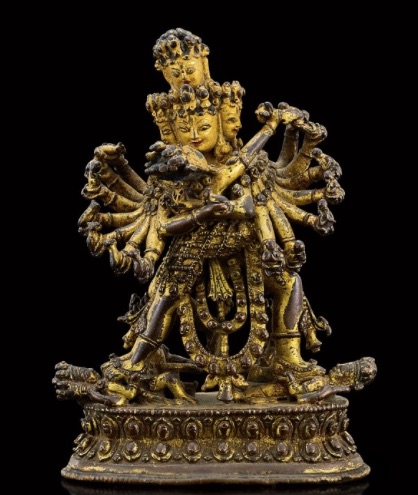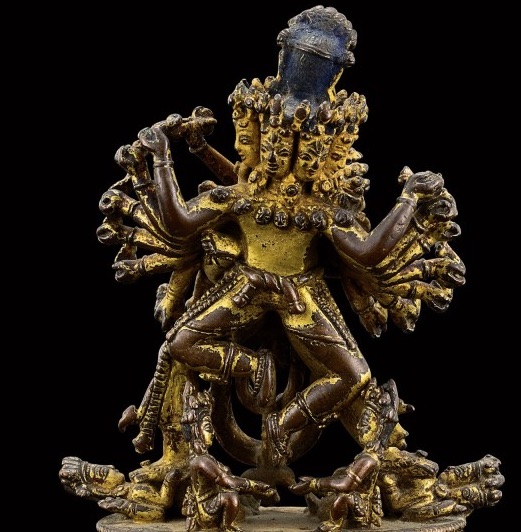
15th century, Nepal, Hevajra, metal (copper or copper alloy), photo on HAR .
Guhyasamaja Hevajra with eight heads (seven plus one, each with three eyes), sixteen arms, and four legs, in embrace with his consort, with eight skull cups containing animals (horse, donkey, bull, camel, elephant, sharabha, cat or owl, and a human) in his right hands, and another eight containing Hindu gods (of water, fire, air, the Earth, the Moon, the Sun, death, wealth) in the left ones. The animals represent diseases that he can eradicate, the gods represent powers that he embodies. Vajranairatmya holds a flaying knife and a skull cup.

16th century, Nepal, Hevajra Kapaladhara and Nairatmya, gilt bronze, private collection, photo on Christie’s .
They may stand on four maras, or on Shiva and Brahma as above (the latter recognisable through his four heads), with Vishnu and Indra seated at the back (with one of their hands raised to support his dangling foot, as pointed out by Christie’s expert).

15th century, Nepal, Hevajra, gilt copper alloy, private collection, photo on Sotheby’s, Paris .

Circa 17th century, Nepal, Hevajra, bronze, 12,8 cm, private collection, International Decorative Arts lot 467, 29th August 2017, Mossgreen.
This popular form is known as kapaladhara (‘skull-cup bearer’).

16th century, Hevajra, gilt bronze, 29 cm, dated by inscription to 1531, private collection, auction 9474 lot 149, 20th September 2000, Christie’s.
Still with his consort, but in his shastradhara (weapon bearer) form, with the same Hindu gods under his feet and behind him. In his main hands he holds a vajra sceptre and a vajra bell. The second left hand from the top makes a threatening gesture (tarjani mudra), the remaining left hands hold a folded lasso, a skull cup, a flaming jewel, a (broken) ritual staff, a bow, a lotus. On the other side he holds a hook (elephant goad), a trident, a skull cup, a staff, a solar wheel, an arrow, a (broken) sword or knife.


























